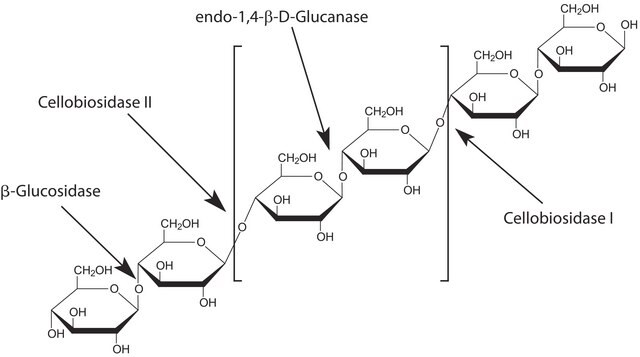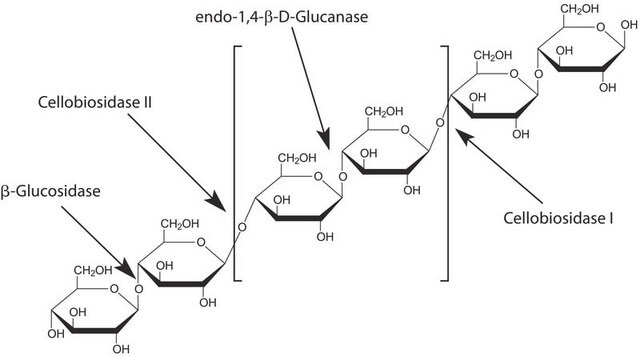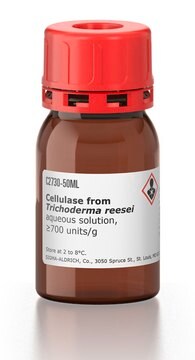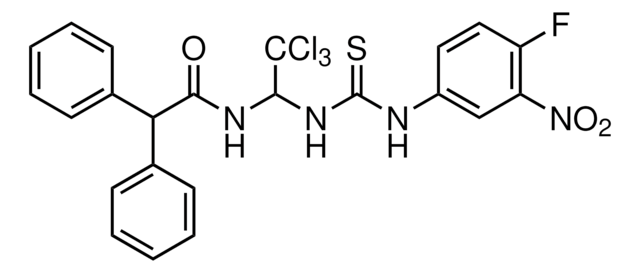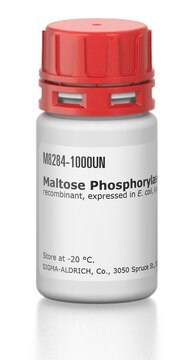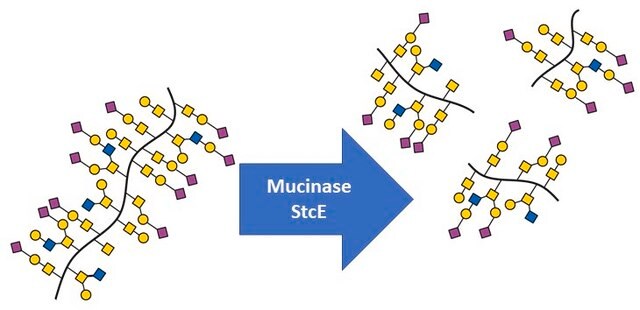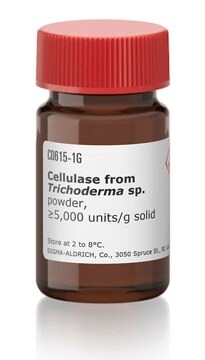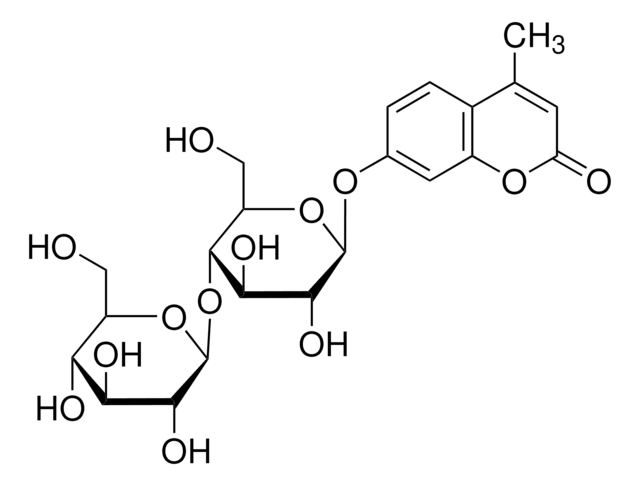E6412
Cellobiohydrolase I from Hypocrea jecorina
0.13 U/mg, recombinant, expressed in corn
Sinónimos:
Cel7A, Cellobiosidase, Cellulase
Iniciar sesiónpara Ver la Fijación de precios por contrato y de la organización
About This Item
Productos recomendados
recombinante
expressed in corn
Nivel de calidad
Formulario
liquid
actividad específica
0.13 U/mg
características de los productos alternativos más sostenibles
Design for Energy Efficiency
Learn more about the Principles of Green Chemistry.
sustainability
Greener Alternative Product
categoría alternativa más sostenible
Condiciones de envío
dry ice
temp. de almacenamiento
−20°C
Descripción general
Cellubiohydrolase I is an enzyme present in many fungi, but particularly wood rot fungi. It is a monomer of 53 kDa with a catalytic domain and a cellulose binding domain. The reaction adds water to the glucose bonds in cellulose (non-reducing ends of the chain), yielding cellobiose.
We are committed to bringing you Greener Alternative Products, which adhere to one or more of The 12 Principles of Greener Chemistry. This product has been enhanced for energy efficiency. Find details here.
Aplicación
Cellobiohydrolase I can be used in combination with endocellulases and b-glucosidase to produce glucose from cellulose.
Acciones bioquímicas o fisiológicas
Cellobiohydrolase (CBH) is a cellulase which degrades cellulose by hydrolysing the 1,4-β-D-glycosidic bonds. CBH is an exocellulase which cleaves two to four units from the ends of cellulose. CBH I cleaves progressively from the reducing end. CBH I is commonly used in detergents for cleaning textiles. Its ezymatic activity ranges from 37° C to 50° C, with its optimal temperature being approximately 45° C. The optimum pH for the enzyme is 5-6.
Definición de unidad
Unit Definition: A unit will turn over 1 nmole of methyl-umbelliferyl beta-D cellobioside per min at pH 5 at 50° C.
Forma física
Provided as an ammonium sulfate precipitate with the source as recombinant maize.
Palabra de señalización
Danger
Frases de peligro
Consejos de prudencia
Clasificaciones de peligro
Resp. Sens. 1
Código de clase de almacenamiento
10 - Combustible liquids
Clase de riesgo para el agua (WGK)
WGK 3
Punto de inflamabilidad (°F)
Not applicable
Punto de inflamabilidad (°C)
Not applicable
Elija entre una de las versiones más recientes:
Certificados de análisis (COA)
Lot/Batch Number
¿No ve la versión correcta?
Si necesita una versión concreta, puede buscar un certificado específico por el número de lote.
¿Ya tiene este producto?
Encuentre la documentación para los productos que ha comprado recientemente en la Biblioteca de documentos.
Los clientes también vieron
Oren Yaniv et al.
Acta crystallographica. Section D, Biological crystallography, 68(Pt 7), 819-828 (2012-07-04)
The crystal structure of the family 3b carbohydrate-binding module (CBM3b) of the cellulosomal multimodular hydrolytic enzyme cellobiohydrolase 9A (Cbh9A) from Clostridium thermocellum has been determined. Cbh9A CBM3b crystallized in space group P4(1) with four molecules in the asymmetric unit and
Jenni Liisa Rahikainen et al.
Bioresource technology, 146, 118-125 (2013-08-08)
Non-productive enzyme adsorption onto lignin inhibits enzymatic hydrolysis of lignocellulosic biomass. Three cellobiohydrolases, Trichoderma reesei Cel7A (TrCel7A) and two engineered fusion enzymes, with distinctive modular structures and temperature stabilities were employed to study the effect of temperature on inhibition arising
Nicolaj Cruys-Bagger et al.
The Journal of biological chemistry, 287(22), 18451-18458 (2012-04-12)
The transient kinetic behavior of enzyme reactions prior to the establishment of steady state is a major source of mechanistic information, yet this approach has not been utilized for cellulases acting on their natural substrate, insoluble cellulose. Here, we elucidate
Nicolaj Cruys-Bagger et al.
Biotechnology and bioengineering, 109(12), 3199-3204 (2012-07-07)
An amperometric enzyme biosensor for continuous detection of cellobiose has been implemented as an enzyme assay for cellulases. We show that the initial kinetics for cellobiohydrolase I, Cel7A from Trichoderma reesei, acting on different types of cellulose substrates, semi-crystalline and
Zachary K Haviland et al.
The Journal of biological chemistry, 297(3), 101029-101029 (2021-08-03)
Understanding the mechanism by which cellulases from bacteria, fungi, and protozoans catalyze the digestion of lignocellulose is important for developing cost-effective strategies for bioethanol production. Cel7A from the fungus Trichoderma reesei is a model exoglucanase that degrades cellulose strands from
Nuestro equipo de científicos tiene experiencia en todas las áreas de investigación: Ciencias de la vida, Ciencia de los materiales, Síntesis química, Cromatografía, Analítica y muchas otras.
Póngase en contacto con el Servicio técnico